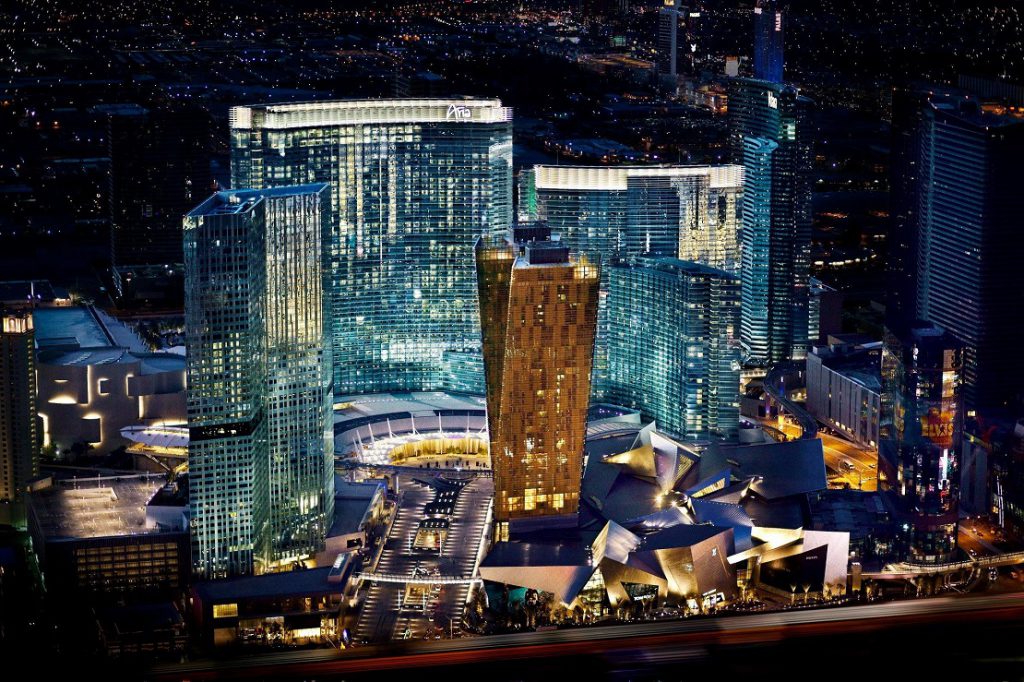City Center Las Vegas


CityCenter
CityCenter (also known as CityCenter Las Vegas) is a 16,797,000-square-foot (1,560,500 m2) mixed-use, urban complex on 76 acres (31 ha) located on the Las Vegas Strip in Paradise, Nevada. The project was started by MGM Resorts International; Dubai World became a joint partner during the project’s construction phase. It is the largest privately funded construction project in the history of the United States. The project is connected by a people mover system to adjacent MGM properties Park MGM and Bellagio Las Vegas. As of 2015, the “CityCenter” branding has been largely retired, with the focus instead on the Aria brand of the development’s centerpiece property in names such as the “Aria Express” (formerly “CityCenter Tram”) and “Aria Art Collection” (formerly “CityCenter Art Collection”).
General design
The project straddles Harmon Avenue and is bordered by (listed clockwise, starting on the east side): Las Vegas Boulevard, the Park MGM, I-15, the Bellagio, and The Cosmopolitan Resort & Casino. The site was formerly occupied by the Boardwalk Hotel and Casino, the Bellagio employee parking lot, and several standalone commercial structures.
The conceptual master plan for Project City Center, announced on November 9, 2004, was designed by Ehrenkrantz, Eckstut & Kuhn Architects, laying out the project with approximately 2,400 condominium and condo-hotel units and approximately 4,800 hotel rooms, distributed within several high-rise towers around The Crystals, an ultra high-end retail mall. It is designed to have all commodities for daily life, featuring a 4,000-room hotel and casino (Aria), two 400-room boutique hotels (The Residences at Mandarin Oriental, with 227 residential condo units, and The Harmon Hotel and Spa), a purely residential offering (Veer Towers), a condo-hotel (Vdara Condo-hotel) and a 500,000 sq ft (46,000 m2) retail and entertainment district which was intended to house the first grocery store directly on the Strip (though as of July 2011, there is no grocery on the property). The multi-use project makes extensive use of green technologies, such as using reclaimed water and an on-site power plant. The Mandarin Oriental, Aria, and Vdara all received LEED certification in November 2009. With a total cost of approximately $9.2 billion, CityCenter is the largest privately financed development in the United States. The original cost estimate was $4 billion, but it was pushed up by rising construction costs and design changes. CityCenter opened with approximately 12,000 employees across the different projects. Vdara, Aria, Mandarin Oriental, and The Crystals opened in December 2009. The Veer Towers opened in July 2010.

Water and ice
CityCenter features five water and ice features. These were designed by WET Design, the company responsible for the Bellagio fountain and the Mirage volcano. Three of these features are located at Aria Resort & Casino, entitled Lumia (a musical fountain), Focus (a water wall on the exterior), and Latisse (a water wall inside the casino). The remaining two are located in The Crystals: Halo (freestanding columns of water vortices) and Glacia (ice pillars).
Construction
The Perini Building Company was lead contractor on the project, with Tishman Construction Corporation serving as the executive construction manager. Gensler was the executive architect overseeing the project. The project was built in three blocks. Block A consisted of the Aria Resort and Casino and surrounding facilities (HKS, Inc. was architect of record); Block B (Leo A. Daly – AOR) holds the Vdara; and Block C (Adamson Associates – AOR) the Mandarin, Veer, Crystals and Harmon structures.
The last remaining permanent building on the project site, the Boardwalk Casino’s mid-rise hotel tower, was imploded May 9, 2006. After most of the design process was complete, construction began without an official groundbreaking ceremony in June 2006. Most renderings of the project were released in September 2006 and some delayed until February 2007. The first concrete was poured on June 26, 2006. Prior to this all of the work was site preparation, including utilities and other infrastructure.[citation needed] A number of construction discrepancies have been found in the project. Construction of various parts of the site were covered by the TV show Build It Bigger in the episode titled CityCenter, Las Vegas.
The building designated for The Harmon was not completed. It was ultimately declared uninhabitable due to construction defects and disassembled from 2014 to 2015.
Accidents
Six deaths have occurred since construction began. On February 6, 2007, a 3,000 lb (1,400 kg) steel wall used as a concrete mold fell from a crane, hitting another wall which struck four workers, killing two. On August 10, 2007, a worker died when the counterweight for a construction elevator came down on him as he oiled the machine. On October 5, 2007, a worker fell approximately 50 ft (15 m) while working on the main resort tower. On April 26, 2008, a worker fell approximately 20 ft (6 m) in the south tower of the Aria Hotel & Casino. On May 31, 2008, a worker was crushed and killed when caught between the counter-weight system and the track of a crane.
Other safety practices by workers have caused concern, with some drinking before work in violation of company rules.
Walk off
At midnight on June 3, 2008, construction workers shut down construction (which had been continuous 24-hours-a-day) by walking off the job to protest safety conditions at the project. The Southern Nevada Building and Construction Trades Council demanded that the general contractor take three steps before they would begin working again: agree to pay for additional safety training for workers, allow national union researchers to examine root causes of safety problems on the site, and allow union leaders full access to the work site.
On the afternoon of June 4, 2008, Perini Building Co. agreed to all of the Southern Nevada Building and Construction Trades Council’s demands and workers resumed work several weeks later at midnight.
No tags for this post.




